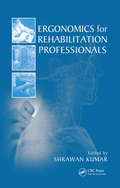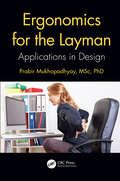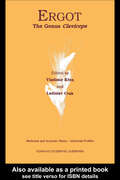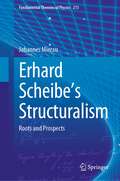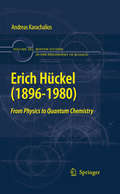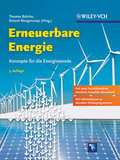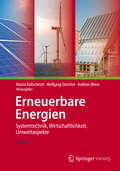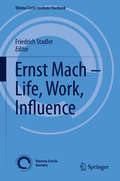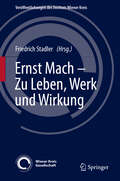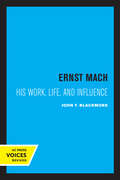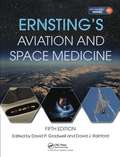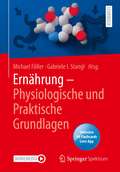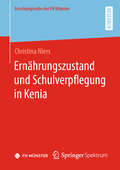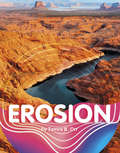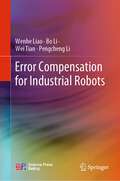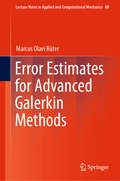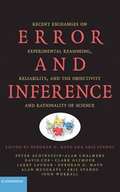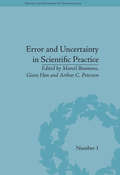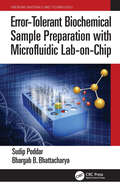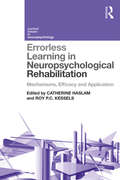- Table View
- List View
Ergonomics for Rehabilitation Professionals
by Shrawan KumarDespite the apparently distinct differences between the disciplines of ergonomics and rehabilitation, they deal with the same issues, although at different ends of the spectrum. Keeping this in mind, Ergonomics for Rehabilitation Professionals explores their philosophies and goals, their parallel, divergent, and complementary aspects. It traces the
Ergonomics for the Layman: Applications in Design
by Prabir MukhopadhyayThis book explains the application of ergonomics in three different areas of design, namely product, space, and communication. The book is written in layman's language and provides examples so that the reader can easily apply the principles to their designs. This book is easy to understand for those without a background in science and technology. It provides a guide for designers from diverse fields ranging from product design to graphic design and shows how to apply ergonomic principles in products from hand-held products to larger products. It explains the application of anthropometric dimensions, as well as how to design for different spaces ranging from bathrooms to cinema halls. It also focuses on the application of communication ranging from displays to graphic design and discusses the significance of color selection. This book is ideal for all design students, practicing designers in any field, design faculty, entry-level engineering students, and anyone who is interested in exploring the field of ergonomics. Features Specifically written in such a way to make it easily understood for those not educated in the field Shows how to apply the ergonomic principles in design Provides an overview of the topic of ergonomics Written in a storytelling format
Ergot: The Genus Claviceps (Medicinal and Aromatic Plants - Industrial Profiles)
by Vladimir Kren Ladislav CvakThis volume provides readers with biotechnological aspects of ergot alkaloid production and genetic and physiological data. Toxicology and environmental risks of ergot infection and contamination of food and forage are also detailed
Erhard Scheibe's Structuralism: Roots and Prospects (Fundamental Theories of Physics #213)
by Johannes MierauThis book offers the first systematic review of the structuralism of physical theories. Particular emphasis is placed on the inclusion of empirical imprecision into formal reconstructions of theories. The proposed measure of imprecision allows for a topological comparison of theories. Considering the ongoing debates on the nature of the thermodynamic limit in statistical mechanics, as well as on limit relations between classical and quantum mechanics, the author asserts that the Bourbaki-style structuralism, together with E. Scheibe's theory of reduction, is the best choice for reconstructing and analyzing the related questions of reduction and emergence. Readers will appreciate the critical overview of the main positions in philosophy of science, examined with particular attention to their applicability to current problems of fundamental theories of physics.
Erich Hückel (1896-1980)
by Andreas KarachaliosThis study, the first comprehensive account of Erich Hückel's career, examines his scientific work as well as his importance for the emergence of quantum chemistry as an independent discipline in Germany during the 1930s. Hückel began his career by studying quantum physics in Göttingen, but his background in chemistry led him to take up pioneering research on the physics of chemical bonding. Drawing on a variety of sources, Andreas Karachalios offers a probing account of fast-breaking developments in quantum theory that paved the way for Hückel's research. In Göttingen and later in Leipzig, Hückel interacted with leading figures not only in quantum physics and physical chemistry but also with others in nearby fields, including organic chemistry and mathematics. During his later career in Marburg, Hückel clashed with Linus Pauling over the properties of the benzine molecule. In order to appreciate this controversy, Karachalios gives a brief account of the mathematical formalism of spin invariants, with both Hückel and Pauling used in their analyses, though with different interpretations. This serves not only to clarify their differences but also to illustrate the importance of the quantum-mechanical theory of resonance for chemistry at this time.
Ernest Nagel: Philosophy of Science and the Fight for Clarity (Logic, Epistemology, and the Unity of Science #53)
by Matthias Neuber Adam Tamas TubolyThis volume is dedicated to the life and work of Ernest Nagel (1901-1985) counted among the influential twentieth-century philosophers of science. Forgotten by the history of philosophy of science community in recent years, this volume introduces Nagel’s philosophy to a new generation of readers and highlights the merits and originality of his works.Best known in the history of philosophy as a major American representative of logical empiricism with some pragmatist and naturalist leanings, Nagel’s interests and activities went beyond these limits. His career was marked with a strong and determined intention of harmonizing the European scientific worldview of logical empiricism and American naturalism/pragmatism. His most famous and systematic treatise on, The Structure of Science, appeared just one year before Thomas Kuhn’s even more renowned, The Structure of Scientific Revolutions. As a reflection of Nagel’s interdisciplinary work, the contributing authors’ articles are connected both historically and systematically. The volume will appeal to students mainly at the graduate level and academic scholars. Since the volume treats historical, philosophical, physical, social and general scientific questions, it will be of interest to historians and philosophers of science, epistemologists, social scientists, and anyone interested in the history of analytic philosophy and twentieth-century intellectual history.
Ernest Thompson Seton: Scout and Naturalist
by Wyatt BlassingameThis naturalist and artist learned much from the Indians, and he wanted to share his knowledge with boys, so that they would love and protect wildlife. Other books by this author are available in this library.
Erneuerbare Energie: Konzepte für die Energiewende
by Herausgegeben VonLeading scientists explain photovoltaics, solar thermal energy, solar air-conditioning, wind and hydroelectric power, fuel cells, energy-efficient buildings, and hydrogen storage for stabilizing networks. Contains about 20% more information than the second edition.
Erneuerbare Energien
by Andreas Wiese Martin Kaltschmitt Wolfgang StreicherDieses Standardwerk stellt die physikalisch-technischen Grundlagen und die aktuelle Systemtechnik für Anlagen zur Nutzung regenerativer Energien zur Strom- und Wärmebereitstellung dar. Außerdem gibt es einen umfassenden Überblick über die Charakteristik des erneuerbaren Energieangebots. Ausgehend davon werden Kennzahlen für eine ökonomische und ökologische Bewertung zugänglich gemacht und die Potenziale der regenerativen Energien und deren derzeitige Nutzung in Deutschland diskutiert. Im Einzelnen werden die folgenden Optionen zur Nutzung des regenerativen Energieangebots aufgezeigt: - passive Solarenergienutzung, - solarthermische Wärmebereitstellung, - photovoltaische und solarthermische Stromerzeugung (u. a. Solarfarm- und Solarturmkraftwerke), - Stromerzeugung aus Windenergie und Wasserkraft, - Wärmebereitstellung mithilfe von Wärmepumpen aus Umgebungsluft und oberflächennaher Erdwärme, - Strom- und Wärmebereitstellung aus der Energie des tiefen Untergrunds. Zusätzlich werden kursorisch die Möglichkeiten einer Nutzung der Meeresenergien dargestellt. Nicht diskutiert wird dagegen die Energiegewinnung aus Biomasse. Für die 5. Auflage wurden u. a. die photovoltaische Stromerzeugung vollständig aktualisiert, die passive und aktive solarthermische Wärmegewinnung umfassend überarbeitet, die Windkraftnutzung einschließlich der Offshore-Windstromerzeugung dem aktuellen Stand der Technik angepasst und die Möglichkeiten einer geothermischen Strom- und Wärmeerzeugung neu strukturiert dargestellt. Außerdem wurden die Grundlagen des regenerativen Energieangebots erweitert. Neben seiner Eignung für die universitäre und außeruniversitäre Lehre bietet das Buch Entscheidungsträgern in Energiewirtschaft, Politik, Verwaltung und Administration sowie Wissenschaftlern und Beratern eine fundierte, verlässliche und hochaktuelle Wissensbasis.
Ernst Mach – Life, Work, Influence (Vienna Circle Institute Yearbook #22)
by Friedrich StadlerThis edited volume features essays written in honor of Ernst Mach. It explores his life, work, and legacy. Readers will gain a better understanding of this natural scientist and scholar who made major contributions to physics, the philosophy of science, and physiological psychology. The essays offer a critical inventory of Mach’s lifework in line with state-of-the-art research and historiography. It begins with physics, where he paved the way for Einstein’s Theory of Relativity. The account continues with Mach's contributions in biology, psychology, and physiology pioneering with an empiricist and gestalthaft Analysis of Sensations. Readers will also discover how in the philosophy of science he served as a model for the Vienna Circle with the Ernst Mach Society as well as paved the way for an integrated history and theory of science. Indeed, his influence extends far beyond the natural sciences -- to the Vienna Medical School and psychoanalysis (R. Bárány, J. Breuer, S. Freud), to literature (Jung Wien, R. Musil), to politics (F. Adler, Austro-Marxism and the Viennese adult education), to arts between Futurism and Minimal Art as well as to social sciences between the liberal school (J. Schumpeter, F. A. von Hayek) and empirical social research (P. Lazarsfeld und M. Jahoda).
Ernst Mach – Zu Leben, Werk und Wirkung (Veröffentlichungen des Instituts Wiener Kreis #29)
by Friedrich StadlerErnst Mach (1838–1916) zählt zu den bedeutendsten Naturwissenschaftlern und Philosophen des 19. und 20. Jahrhunderts. In der Physik gilt er als Wegbereiter von Einsteins Relativitätstheorie und Kontrahent von Boltzmanns Atomistik. In der Biologie, Psychologie und Physiologie wird er als Pionier einer empiristischen und gestalthaften „Analyse der Empfindungen“ betrachtet. In der Wissenschaftsphilosophie schließlich war er Vorbild des Wiener Kreises mit dem Verein Ernst Mach und Wegbereiter einer integrierten Wissenschaftsgeschichte und Wissenschaftstheorie.Der Band versammelt die deutschsprachigen Beiträge zum Symposium anlässlich des 100. Todestages von Ernst Mach. Im Mittelpunkt der internationalen Konferenz im Juni 2016 an der Universität Wien und der Österreichischen Akademie der Wissenschaften standen Leben, Werk und Wirkung des Naturforschers und Philosophen. Der Band bietet eine kritische Bestandsaufnahme von Machs Lebenswerk vor dem Hintergrund der aktuellen Forschung und Historiografie.Die Autoren untersuchen unter anderem• seine Bedeutung für die Herausbildung einer naturwissenschaftlichen Psychologie• Machs historisch-kritische Methode• die Rolle der Kinematographie• die Rezeption durch Aleksander Bogdanov• das Verhältnis zu Sigmund Freuds Psychoanalyse Der Band erscheint in der Reihe „Veröffentlichungen des Instituts Wiener Kreis“ und richtet sich an Forschende auf den Gebieten der Wissenschaftsphilosophie, -geschichte und -theorie sowie der Kulturwissenschaften und der Wahrnehmungspsychologie.
Ernst Mach: His Life, Work, and Influence
by John T. BlackmoreThis title is part of UC Press's Voices Revived program, which commemorates University of California Press’s mission to seek out and cultivate the brightest minds and give them voice, reach, and impact. Drawing on a backlist dating to 1893, Voices Revived makes high-quality, peer-reviewed scholarship accessible once again using print-on-demand technology. This title was originally published in 1972.
Ernsting's Aviation And Space Medicine
by David DavidErnsting's Aviation and Space Medicine applies current understanding in medicine, physiology and the behavioural sciences to the medical challenges and stresses that are faced by both civil and military aircrew, and their passengers, on a daily basis. <p><p> The fifth edition of this established textbook has been revised and updated by a multi-disciplinary team of experienced contributors, and includes new chapters on space physiology and medicine, passenger safety, rotary wing operation by land and sea, and UAVs. It remains the recommended textbook for those studying for the Diploma in Aviation Medicine of the Faculty of Occupational Medicine of the Royal College of Physicians, recognized worldwide as a standard in the field, and for similar overseas qualifications. <p> Ernsting's Aviation and Space Medicine remains an essential companion for all civil and military aviation medicine practitioners, both when preparing for professional examinations and in daily practice, and for those in the many disciplines of the behavioural and life sciences that include some study of aviation, its physiology and related issues. It is also recommended reading for those with a wider interest in the medical problems of professional or recreational flying, air transport and the aviation industry.
Ernährung - Physiologische und Praktische Grundlagen
by Wim WätjenWas geschieht mit den verzehrten Lebensmitteln im Körper? Welche Nährstoffe brauchen wir in welchem Lebensalter, und kann Nahrung auch schädlich sein? Das Lehrbuch gibt einen umfassenden Überblick über die ernährungsphysiologischen Grundlagen, die zum erfolgreichen Bestehen eines ernährungswissenschaftlichen Studiums erforderlich sind. Kurze einführende Beispiele eröffnen die Kapitel und werfen so wichtige Fragen auf, die im weiteren Verlauf aufgegriffen werden. Zahlreiche Abbildungen und Kurzzusammenfassungen erleichtern das Lernen und die Prüfungsvorbereitung. Das Lehrbuch beschreibt auf anschauliche Weise, wie Nährstoffe aufgenommen werden, welche Funktionen sie im Körper haben und welcher Regulation sie unterliegen. Weitere Kapitel befassen sich mit den verschiedenen Methoden der Ernährungserhebung und den besonderen Nährstoffbedürfnissen von Menschen im Laufe ihres Lebenszyklus sowie mit der Ernährungstoxikologie. Das Lehrbuch greift in einzigartiger Weise auch die vorgeburtliche Ernährung auf und behandelt, wie wir Nahrungsmittel schmecken und riechen, wie die Gefühle von Hunger und Sättigung entstehen und welche Inhaltsstoffe von Lebensmitteln uns schaden.
Ernährung bei Eisenmangel: Stoffwechsel - Bioverfügbarkeit - Diagnostik
by Klaus GüntherRund ein Viertel der Weltbevölkerung ist von Eisenmangel betroffen, als besondere Risikogruppe gelten Frauen im gebärfähigen Alter sowie Kinder und Jugendliche. Das Fachbuch beschäftigt sich mit den neuesten wissenschaftlichen Erkenntnissen rund um die Eisenversorgung des menschlichen Organismus mit natürlichen Lebensmittel. Dabei räumt es mit dem Irrglauben auf, dass pflanzliches Eisen weniger wertvoll ist als tierisches Eisen, indem es die Eisenaufnahme aus pflanzlichen Lebensmitteln über einen neu entdeckten Stoffwechselweg vorstellt. Daraus lassen sich neue Gesichtspunkte für Vegetarier und Veganer ableiten, die bislang zur Risikogruppe zählten. Des Weiteren widmet es sich den vielfältigen Diagnosemöglichkeiten eines Eisenmangels und beschreibt gängige Methoden zur Bestimmung der Bioverfügbarkeit von Eisen in Lebensmitteln. Neue Erkenntnisse über die Biochemie des Eisens im Hirnstoffwechsel, die Wechselwirkung von Eisen mit anderen Spurenelementen sowie praktische Hinweise für besondere Ernährungsweisen, Risikogruppen und Altersklassen und Kochrezepte mit einfachen Angaben zur Eisenaufnahme komplettieren das Werk. Das Buch richtet sich an Ernährungs- und Allgemeinmediziner, Ernährungs- und Lebensmittelwissenschafter, Diätologen, Apotheker und Ernährungsberater.
Ernährung in der Altenbetreuung: Esskultur, Biographie und Religion im Verpflegungsalltag
by Susanne BayerSo verschieden die individuellen Ernährungsvorlieben und Gebräuche sind, so unterschiedlich sind die Bedürfnisse älterer, betreuungsbedürftiger Menschen. Das Buch fasst die Empfehlungen für bedarfs- und bedürfnisgerechte Ernährung in der Geriatrie leicht verständlich zusammen und geht darüber hinaus auf spezielle Bedürfnisse aus der Biografie und der Religion der zu betreuenden älteren Menschen ein. In Bezug auf die Lebensqualität nimmt das Essen in der Altenbetreuung immer einen zentralen Stellenwert ein.Gemeinsamkeiten und Unterschiede von Ernährungsgewohnheiten in verschiedenen Religionen und praxisbezogene Hilfestellungen für den Verpflegungsalltag komplettieren das Buch. Mit den vielen Ratschlägen können Konflikte vermieden und die Essenssituation kann für alle Seiten angenehm gestaltet werden. Ein wichtiger Teil sind die Geschichten und Rezepte der hochaltrigen Menschen, sie helfen ein Verständnis für die individuellen Bedürfnisse zu entwickeln. Zum leichteren Nachkochen unterstützen die Videos.Das Buch richtet sich an Betreuende und Pflegende älterer Menschen, aber auch soziale Dienstleister und Ausbildungseinrichtungen werden darin Impulse für ihre Arbeit erhalten.
Ernährung in der Altenbetreuung: Esskultur, Biographie und Religion im Verpflegungsalltag
by Susanne BayerSo verschieden die individuellen Ernährungsvorlieben und Gebräuche sind, so unterschiedlich sind die Bedürfnisse älterer, betreuungsbedürftiger Menschen. Das Buch fasst die Empfehlungen für bedarfs- und bedürfnisgerechte Ernährung in der Geriatrie leicht verständlich zusammen und geht darüber hinaus auf spezielle Bedürfnisse aus der Biografie und der Religion der zu betreuenden älteren Menschen ein. In Bezug auf die Lebensqualität nimmt das Essen in der Altenbetreuung immer einen zentralen Stellenwert ein.Gemeinsamkeiten und Unterschiede von Ernährungsgewohnheiten in verschiedenen Religionen und praxisbezogene Hilfestellungen für den Verpflegungsalltag komplettieren das Buch. Mit den vielen Ratschlägen können Konflikte vermieden und die Essenssituation kann für alle Seiten angenehm gestaltet werden. Ein wichtiger Teil sind die Geschichten und Rezepte der hochaltrigen Menschen, sie helfen ein Verständnis für die individuellen Bedürfnisse zu entwickeln. Zum leichteren Nachkochen unterstützen die Videos.Das Buch richtet sich an Betreuende und Pflegende älterer Menschen, aber auch soziale Dienstleister und Ausbildungseinrichtungen werden darin Impulse für ihre Arbeit erhalten.
Ernährungszustand und Schulverpflegung in Kenia (Forschungsreihe der FH Münster)
by Christina NiersWeltweit hungern 821 Millionen Menschen, vor allem in den Entwicklungsländern. Eine Mangel- und Unterernährung ist für Kinder bis zum fünften Lebensjahr besonders gefährlich und kann ihre Entwicklung irreversibel schädigen.In diesem Buch wird der Ernährungszustand von 174 Vorschul- und Schulkindern aus Diani / Kenia erfasst. Bei 30 Kinder wurde eine Mangel- und/oder Unterernährung beobachtet (Stunting, Wasting und / oder ein reduziertes MUAC). Ein Kind war besonders unterernährt und ein Kind war übergewichtig. Die Ernährungserhebung zeigt, dass vor allem die Versorgung mit Energie, Fett, Proteinen, Vitamin A, Vitamin C, Calcium und Eisen durch die Schulversorgung nicht ausreicht.Auf Grundlage der erhobenen Daten wird eine Strategie für eine nachhaltige Verbesserung der Schulverpflegung entwickelt.Christina Niers hat nach ihrer Ausbildung zur Gesundheits- und Krankenpflegerin (2012) an der Hochschule Osnabrück das Ökotrophologie-Studium absolviert (2015). Seitdem ist sie im Ernährungsmanagement von krankheitsbedingt mangelernährten Patienten tätig. Im Jahr 2019 hat sie das Masterstudium Ernährung und Gesundheit an der Fachhochschule Münster abgeschlossen.
Erosion (Earth Materials and Systems)
by Tamra B. OrrErosion changes Earth's natural features. It breaks down materials and can help make something new. Discover why erosion is an important part of nature!
Error Compensation for Industrial Robots
by Wenhe Liao Bo Li Wei Tian Pengcheng LiThis book highlights the basic theories and key technologies of error compensation for industrial robots. The chapters are arranged in the order of actual applications: establishing the robot kinematic models, conducting error analysis, conducting kinematic and non-kinematic calibrations, and planning optimal sampling points. To help readers effectively apply the technologies, the book elaborates the experiments and applications in robotic drilling and milling, which further verifies the effectiveness of the technologies. This book presents the authors’ research achievements in the past decade in improving robot accuracy. It is straightforwardly applicable for technical personnel in the aviation field, and provides valuable reference for researchers and engineers in various robotic applications.
Error Estimates for Advanced Galerkin Methods (Lecture Notes in Applied and Computational Mechanics #88)
by Marcus Olavi RüterThis monograph provides a compendium of established and novel error estimation procedures applied in the field of Computational Mechanics. It also includes detailed derivations of these procedures to offer insights into the concepts used to control the errors obtained from employing Galerkin methods in finite and linearized hyperelasticity. The Galerkin methods introduced are considered advanced methods because they remedy certain shortcomings of the well-established finite element method, which is the archetypal Galerkin (mesh-based) method. In particular, this monograph focuses on the systematical derivation of the shape functions used to construct both Galerkin mesh-based and meshfree methods. The mesh-based methods considered are the (conventional) displacement-based, (dual-)mixed, smoothed, and extended finite element methods. In addition, it introduces the element-free Galerkin and reproducing kernel particle methods as representatives of a class of Galerkin meshfree methods. Including illustrative numerical examples relevant to engineering with an emphasis on elastic fracture mechanics problems, this monograph is intended for students, researchers, and practitioners aiming to increase the reliability of their numerical simulations and wanting to better grasp the concepts of Galerkin methods and associated error estimation procedures.
Error and Inference: Recent Exchanges on Experimental Reasoning, Reliability, and the Objectivity and Rationality of Science
by Deborah G. Mayo Aris SpanosAlthough both philosophers and scientists are interested in how to obtain reliable knowledge in the face of error, there is a gap between their perspectives that has been an obstacle to progress. By means of a series of exchanges between the editors and leaders from philosophy of science, statistics, and economics, this volume offers a cumulative introduction connecting problems of traditional philosophy of science to problems of inference in statistical and empirical modeling practice. Philosophers of science and scientific practitioners are challenged to reevaluate the assumptions of their own theories - philosophical or methodological. Practitioners may better appreciate the foundational issues around which their questions revolve and thereby become better "applied philosophers." Conversely, new avenues emerge for finally solving recalcitrant philosophical problems of induction, explanation, and theory testing.
Error and Uncertainty in Scientific Practice (History and Philosophy of Technoscience #1)
by Marcel Boumans Giora Hon Arthur C. PetersenAssessment of error and uncertainty is a vital component of both natural and social science. This edited volume presents case studies of research practices across a wide spectrum of scientific fields. It compares methodologies and presents the ingredients needed for an overarching framework applicable to all.
Error-Tolerant Biochemical Sample Preparation with Microfluidic Lab-on-Chip (Emerging Materials and Technologies)
by Bhargab B. Bhattacharya Sudip PoddarMicrofluidic biochips have gained prominence due to their versatile applications to biochemistry and health-care domains such as point-of-care clinical diagnosis of tropical and cardiovascular diseases, cancer, diabetes, toxicity analysis, and for the mitigation of the global HIV crisis, among others. Microfluidic Lab-on-Chips (LoCs) offer a convenient platform for emulating various fluidic operations in an automated fashion. However, because of the inherent uncertainty of fluidic operations, the outcome of biochemical experiments performed on-chip can be erroneous even if the chip is tested a priori and deemed to be defect-free. This book focuses on the issues encountered in reliable sample preparation with digital microfluidic biochips (DMFBs), particularly in an error-prone environment. It presents state-of-the-art error management techniques and underlying algorithmic challenges along with their comparative discussions. Describes a comprehensive framework for designing a robust and error-tolerant biomedical system which will help in migrating from cumbersome medical laboratory tasks to small-sized LOC-based systems Presents a comparative study on current error-tolerant strategies for robust sample preparation using DMFBs and reports on efficient algorithms for error-tolerant sample dilution using these devices Illustrates how algorithmic engineering, cyber-physical tools, and software techniques are helpful in implementing fault tolerance Covers the challenges associated with design automation for biochemical sample preparation Teaches how to implement biochemical protocols using software-controlled microfluidic biochips Interdisciplinary in its coverage, this reference is written for practitioners and researchers in biochemical, biomedical, electrical, computer, and mechanical engineering, especially those involved in LOC or bio-MEMS design.
Errorless Learning in Neuropsychological Rehabilitation: Mechanisms, Efficacy and Application (Current Issues in Neuropsychology)
by Catherine Haslam Roy P.C. KesselsErrrorless learning is one of the most studied principles in neurorehabilitation. This is the first volume to capture all the key elements in the field in one invaluable resource, providing an up-to-date and broad analysis of the use of errorless learning principles in rehabilitation after brain injury. With contributions from key researchers in the field, Errorless Learning in Neuropsychological Rehabilitation covers the historical foundations of errorless learning, current understanding of underlying mechanisms which support learning and its use in memory and language in rehabilitation as applied to particular populations across the age span. This volume also addresses questions of efficacy through analysis of research comparing errorless learning with other established learning methods and principles. Errorless Learning in Neuropsychological Rehabilitation is an essential resource for practitioners, researchers and students of psychology, neuropsychology and rehabilitation.
